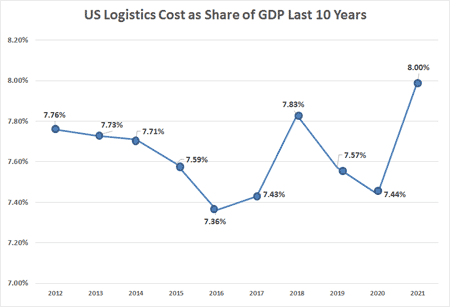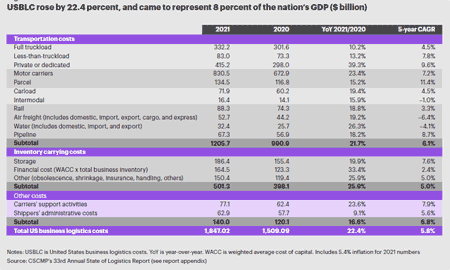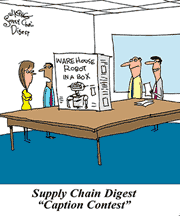State of the Logistics Union 2022
The Council of Supply Chain Management Professionals (CSCMP) and partners Kearney and Penske Logistics are out this week with the 2022 State of Logistics Report, looking primarily at 2021 data.
It is a mammoth effort, and one which takes six months from the end of the preceding year to produce the report in mid-June. The result of that time lag, seemingly unavoidable, is that the review of what happened in the previous year halfway through the current one makes the data modestly stale.
| GILMORE SAYS: |
WHAT DO YOU SAY?'
The US thus spent about $46.2 billion more in parcel shipping than it did in rail transport last year - a bit more than a delta of $44.3 billion in 2020..
Send us your
Feedback here
|
Kearney took over the job seven years ago, and I will say it has done a good job providing the analysis of 2021 but also bringing in more timely data and trends.
Before my review and comment on this year's report, let me first congratulate my friend Mark Baxa, whom I first met many years ago when he was at Monsanto, on his recently being named permanent CEO of CSCMP.
Long active in the organization, Baxa was named interim CEO in early 2021 after long time head Rick Blasgen suddeny left his post.
After Baxa took the interim spot, a supposed global search ensued, but in the end the board decided that Baxa was their man. Well deserved congrats to him in a very crtical period of time for CSCMP.
Back to the 2022 SOL report.
Five Kearney consultants are cited as the report's authors, with shout outs to dozens of other people and organizations that helped.
Again this year, Penske Logistics funded the report development.
This is actually the 33rd edition of the State of Logistics report, which was launched in 1988 by the late Bob Delaney and sponsored by his company, Cass Information Systems. Somewhere along the way, CSCMP took over the sponsorship.
As always, the headline news: what the report several years back started calling US Business Logistics Costs (USBLC) rose sharply on an absolute basis in 2021 to 1.85 trillion. That was an increase of 22.4% from an economically weak 2020.
With a smaller increase in US nominal GDP (10%) than logistics cost rose last year (22.4%), that took the relative cost of logistics as a share of GDP to 8.0%, up significantly from 7.44% in 2020.
To get to this key ratio, you take the amount of US logistics costs - from trucking to pipelines - and divide it by annual nominal (not real) GDP numbers. Voila, logistics costs as a percent of GDP emerges. The methodology must use nominal not real GDP as the denominator because the costs for the year are compiled in nominal terms, not inflation adjusted.
Oddly, this year's report did not include the chart showing logistics costs as a percent of GDP for the last 10 year that always had been provided, so I made my own using SOL report data, as shown below (note: I used the historical numbers provided last year in the report. It is possible they underwent some small unreported revisions this year):

Source: CSCMP/Kearney
As seen in the graphic, with rising rates and fuel costs in 2021, logistics spend as a share of the economy was at its highest in a decade.
In 2012 through 2020, US logistics costs ranged between just 7.36% and 7.83% of GDP, ratther remarkable stability, it seems to me. But now a big jump in 2021.
In recent years, I noted you could say the US was overall making some progress in driving logistics costs down. Despite the modest jump in 2018, costs as a share of GDP in general have been trending down over the past decade, and that seen even with the high costs of rapidly growing ecommerce fulfillment embedded in the numbers. But the progress came to a halt last year
The peak in the past 15 years was 2007 (not on chart), when logistics costs hit 8.59% of GDP, close to where it was in 2008 (8.5%) before taking a steep drop in the recession year of 2009 to 7.4%. I will note the 2007-08 numbers were calculated using a somewhat different methodology than is being used now, meaning that the comparisons of those numbers to recent years is somewhat flawed, though I don't think by much.
What was behind the large jump in logistics spend versus GDP? Supply and demand as usual. From the report: "Disruptions in all logistics networks effectively destroyed capacity, ships loitered at ports, equipmemt waited to be unloaded, and trucks rushed out half empty, dashing off to the next high paying load with little regard to backhauls."
Kearney says the average annual growth in logistics costs - again including inflation - is 5.8% over the past five years. My calulation is that nominal GDP growth over the past 5 years is 4.8%, suggesting logistics cost have been rising a bit below the growth in the economy.
Underneath the overall logistics cost number, transportation costs - the largest single component of USBLC at 65.2% of the total (versus 68% in 2020) - was up 21.7%, and again an average of 6.1% annually over the past five years.
The second component, inventory carrying costs (27.1% of the total, versus 24.5% in 2020), was up 25.9% last year under the report's calculation, which includes the cost of warehousing and inventory levels but also the cost of capital (which drives the cost of holding inventory).
While inventory levels fell last year, the cost of storing, handling and financing them spiked.
"Other" costs - always somewhat vague and mostly related to certain IT expenses and some services such as freight forwarding - were up 16.6%, though this is by far the smallest of the three main categories at just 7.5% of the total number (same as in 2020.
You can find the full breakdown by logistics cost bucket in the chart below:

Source: CSCMP/Kearney
See Full Size Image
Within transportation, trucking-related spend (including private fleets but excluding parcel) comprised 69% of total transport costs and 45% of total logistics spend, up a bit from 44% in 2020.
Parcel shipping costs were estimated at $134.5 billion, up 15.2% over 2020, slower than the 23% growth two years ago. That again represented 11.1% of total transport costs and 7.2% of total logistics spend, the latter down from 7.6% in 2020. Over the past five years, parcel costs have risen by 11.4% on average.
At $88.3 billion in 2021, rail comprised 7.3% of transportation spend - up from 7.0% last year. Rail was also 4.7%, of the total logistics costs, the same as in 2020.
The US thus spent about $46.2 billion more in parcel shipping than it did in rail transport last year - a bit more than a delta of $44.3 billion in 2020.
In terms of growth in spending by these various categories, the 5-year average annual growth rate in costs by mode or cost category are as follows, according to the report:
• Truckload: 4.5%
• LTL: 7.8%
• Private/dedicated fleet: 9.6%
• Trucking combined: 7.2%
• Parcel: 11.4%
• Rail: 3.3%
• Air freight: -6.4%
• Waterways: -4.1%
• Warehousing: 7.5%
For the second straight year there are some significant changes in some of these CAGR numbers from the 2021 report, and I am not sure what caused these changes in just one year. I suspect the issue is actually revision of the prior data.
With overall tranport costs rising 6.1% per year over the past five years, comparing the rise in any specific areas versus that 6.1% overall number will indicate whether a category gaining or losing share of total spend (note: that is not the same as tonnage share changes, though I suspect the numbers would be similar).
The report has a lot more detail on each mode and cost bucket, as well as on the overall economic and logistics environment, which I don't have room for here.
The report also includes special sections on sustainability, M&A, and (yet again) control towers. I will review these in a follow up column. But my first reaction is that there is less of this add-on material than in recent years.
My bottom line view: Kearney and CSCMP continue to improve this report, and it is well worth a read. It continues to improve in integrating current trends and data with last year's numbers that are the heart of the report. But please bring back the chart showing the last 10 years of logistics costs as a percent of GDP, and explain the big changes in 5-year CAGR numbers by mode in one year.
CSCMP members can download a copy for no charge, and others can purchase one for a modest fee. I recommend it.
Any reaction to our summary of this year's State of Logistics report? How could the report be improved? Let us know your thought at the Feedback section below.
|











